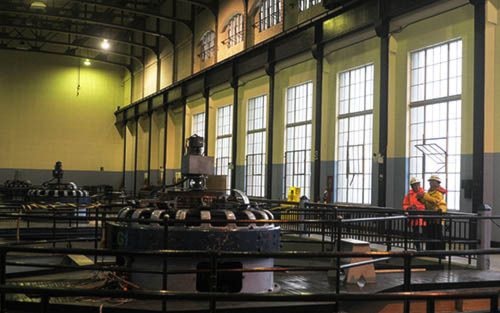Readying a 80-year-old dam for the big one and replacing old turbines of the same vintage is not something that can be done on a Saturday afternoon.
But B.C. Hydro is making good progress on the $718-million Ruskin Dam and Powerhouse renovation, says Judy Dubrowolski.
So far, work on the first stage, strengthening the northwest part of the dam abutment, is going well. That involves drilling holes into the soil, which anchors one end of the dam, and forcing down concrete to reinforce the bank. It’s called jet grouting and has to be done to strengthen the soil conditions.
Currently, water is already seeping through the abutment. If a quake hits – such as the 7.7 magnitude one near Haida Gwaii on Oct. 27 – “We could run into problems,” Dubrowolski said.
“There’s no danger,” now, “but we know water is seeping through.”
Work started last April and has moved to another phase – gutting and rebuilding and seismically strengthening the powerhouse which houses the huge turbines that are driven by the water and produce the power, enough electricity for 35,000 homes.
Once complete, the dam will be able to withstand a one-in-10,000-year earthquake.
A major part of the dam that starts next summer is replacing the seven-year-old spillway gates at the top of the structure with five new, wider stronger gates.
That’s a multi-year project that will be completed about the time the project finishes in about 2018.
Doing that will have the effect of widening the top of the dam, so instead of just a single lane traffic being able to drive across, there will be two lanes, along with a sidewalk.
“That’s a huge recreational boon because we’ll be able to better link the railway trail with the hiking trail,” Dubrowolski added.
A major part of the project is moving the switchyard from atop the power house to a nearby bank, which is a safer location.
Another major part of the project is replacing the three aging turbines, one of which was installed in 1930, while the second and third were added in 1938 and 1950. The new turbine-generators will come from Brazil, costing about $80 million, will be installed in 2014-2017.
“While they’ll be new, they won’t be that much more efficient than their predecessors. The new turbine-generators will be pump out only about eight-per-cent more power.
The lower part of the dam, built in 1930, is almost as good as new and doesn’t need any work.
“The dam structure itself is safe and secure,” Dubrowolski said.
“The driver for this project is seismic upgrade and safety and just replacing what is a really old facility.”
But it is an important facility, Dubrowolski said. “The main driver is to keep it going for the next 50 to 80 years.
“Personally, I think it’s beautiful. I think it’s getting old, though.”
